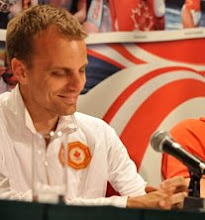Note: this post contains a factual error. Read the correction.
Yesterday (read part 1) I wrote about Sport Canada funding and spending trends from 1995 to 2003. The discussion was motivated by the recent federal budget, and the subsequent announcement that $55M a year in Sport Canada money would be contributed to the Own the Podium program for winter Olympic sports.
There were two main conclusions:
- Funding for amateur sport in Canada has been on a steady increase since reaching a low point in 1997-98.
- Most of the increased spending has been directed to the Athlete Assistance Program (AAP), and National Sport Federations (NSFs) for summer and winter Olympic sports.
Figure 2

Figure 2 — Sport Canada funding distribution for Olympic sports, 1995-2003 (click to enlarge).
Today I'd like to talk about how that "Olympic Sports" total is divided between the various organizations that receive it. Figure 2 (inset right) shows the same eight years as we saw in Figure 1, but this time I've only plotted the Olympic Sports category. I've broken it down into individual recipients, with the blue bars representing winter sports, the red-to-yellow bars representing summer sports, and the black cap at the top representing the amount given to the COC and a couple of other organizations. The vertical axis is now the percentage of the total Olympic Sports spending, because I want to look at how the distribution changed between 1995 and 2003.
The primary conclusion seems to be that the distribution didn't change much. There hasn't been, at least up until 2003, a big shift in the emphasis on winter or summer sports; the proportions have remained about the same. Summer sport NSFs took a bigger piece of the pie in 2000-01, a summer Olympic year, and a smaller proportion in 1997-98, a winter Olympic year. Interestingly, 1996-97, also a summer Olympic year, does not appear to have been a particularly good year for summer sports.
We could use the past to do a simplistic forecast for the future. If Own the Podium dumps $55M into winter Olympic sports each year, then one of two things is going to happen. Either the current summer-winter balance (about 2.5 to 1) is going to shift significantly, or the federal government is going to come up with $135M per year for the summer version of Own the Podium. Since the current plan is $140M per year of total funding, I don't believe that the second option is viable.
Within the winter and summer categories, I would also conclude that there has not been a major change in the distribution of money. For the summer sports, I have broken out the ten largest recipients, which get about half of the total summer Olympic NSF money. Similarly for winter sports, the top four NSFs get about half of the money, and nothing changed dramatically between 1995 and 2003.
It's also interesting to examine the list of top recipient NSFs. In general, this reads like the list of sports where Canada is competitive; or in the case of swimming and alpine skiing, where we once-were-and-could-be-again competitive. The glaring exceptions are the three summer team sport NSFs, where we can't even qualify consistently. I suspect that this is deceiving for a couple of reasons. First of all, the volleyball NSF also includes beach volleyball, where Canada has been competitive. More importantly, the Sport Canada contribution includes all funding for NSFs, not just the part that is allocated to high-performance or national team programs. As a general rule, the high-performance programs consume the lion's share of the money. However, it is possible that a sport like basketball, with very high grassroots participation, may spend a bigger fraction of its funding on development and participation at the local club level. In this sense the comparison between NSFs is not entirely fair.
I was surprised, however, to see in this story that the summer sport NSFs are going to "try especially hard" to obtain increased funding for team sports. That seems like a dubious strategy for winning more medals, to me. To succeed in any team sport, you need to develop and support a large number of athletes (say 20 or so), which is expensive, and then there is only one medal at stake. I also think that Canada, with its expansive geography and sparse population, is starting at a natural disadvantage in large-team sports. It would make more sense, if your goal is simply to win more medals at the summer Olympics, to focus your funding on individual or small-team sports where there are a large number of medals available.


No comments:
Post a Comment